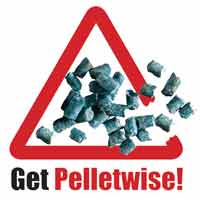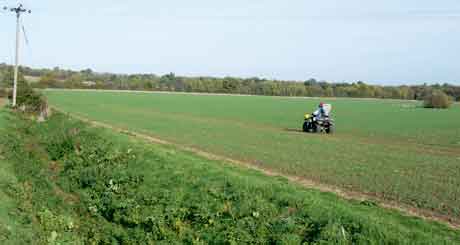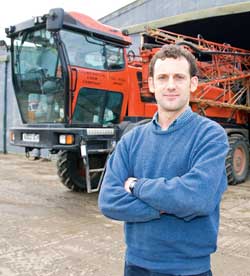Get Pelletwise: Care crucial to keep watercourses clean

It is crucial to remember that pellets are pesticides, and should be treated as such when applying to crops this autumn. A little common sense can go a long way to minimising the risks of water contamination.
In the UK slugs can cause up to £200m worth of damage in arable crops a year. Without adequate control measures winter oilseed rape production would become almost impossible and cereal crops would be more vulnerable to yield loss.
“So a little extra effort is worthwhile – the future of the UK’s preferred slug protection product is in your hands,” says agricultural mechanisation consultant Bill Basford.
Discover how to avoid being a pellet pillock in the latest Get Pelletwise video.
OPERATIONS
Start with the main tramlines, leaving two headland bout widths and finish with the headlands to avoid carrying pellets onto the road in mud on the wheels when leaving. This action also avoids wheel damage to pellets while headland turning.
Also establish a 5m no-spread zone adjacent to any water. This is recommended by all the manufacturers. “This area is commonly grassed down as part of ELS measures, but if not remember little real slug grazing is seen in this area, particularly as the soil is likely to be more compact, thereby restricting slug movement and damage,” notes Mr Basford. Rolling is a good cultural control method particularly close to headlands.
 |
|---|
| Keep pellets out of ditches and watercourses and clean machines in the field. |
Don’t apply pellets within 5m of ditches. The future of slug pellets is in your hands – for more go to www.getpelletwise.co.uk |
Pellets should never be applied to saturated ground. If the field drains are already running, or expected to start running, don’t spread. Similarly, do not spread if further heavy rainfall is forecast.
CLEANING
Before leaving the field brush the machine down. Chose a spot to do this. in the field well away from headlands, gateways or where there is a risk to water.
Decontamination experiments undertaken by ADAS show that accumulated soil and pellets around the machine can be a significant source of metaldehdye, containing almost 6g of active ingredient. But simple dry brushing in the field removes 90% of such residues. Washing with water only removed a further 4% of the total metaldehyde.
If left uncleaned an ATV and applicator could harbour 6g of metaldehyde, enough to cause significant contamination of a large stretch of surface water if it was washed into it by rain. If washing in the yard use a dedicated handling area, as you would when washing down a sprayer.
When cleaning always wear PPE clothing and never use a pressure washer – the highly concentrated contaminated water that results is likely to find its way to a yard drain. Air lines must also be avoided as this can lead to pellets being thrown all over the place.
If replacing parts in the yard, put down a plastic sheet to capture any stray pellets that may fall from a machine, even when it has been cleaned before servicing.
In season always keep the machine under cover between periods of work and ensure the machine is thoroughly cleaned before long term storage.
DISPOSAL
Waste should be stored safely, including coveralls, empty containers and any cleanings. Use a licensed disposal operator and make sure they transport waste safely, this is your responsibility. Be sure to complete a waste transfer notice.
Cambridgeshire farmer brushes up tactics

Everyone has a role to play in safeguarding the future of metaldehyde slug pellets, says Cambs farmer Andrew Crossley
“Nipping slug pressure in the bud is the key,” says Andrew Crossley, farm manager for the 2600ha Pemberton family operation near Cambridge and Peterborough.
He is well placed to comment, with oilseed rape taking a key place in the rotation at Trumpington Farm Company and Thorney Farms. As vice-chairman of the NFU Eastern Region combinable crops board he also has a good insight into pesticide politics.
“If pelleting is done efficiently and in good time in the first place, it does reduce the need for further applications. In our experience it is the fire-brigade applications, later in the season, which are chasing slug populations, demand higher rates and go on in wetter conditions when efficacy is reduced. Getting it right from the outset is the key.
“We check the riskiest situations first, after oilseed rape on heavy land and we find we often don’t need to pellet as much as we might expect.”
Appropriate use is made of deterrent seed treatment Deter (clothianidin) where severe pressure and multiple applications are expected. “It definitely helps.”
Seed rates can be increased on headlands where pellet application may be trickier and pellets are included in the drill on one farm. “At least they are buried with the seed where the slug pressure will initially come from and there’s no risk of them getting onto field margins,” he says.
Where pellets do need broadcasting special care is taken on headlands. “We have a 10m broadcaster mounted on the tractor towing 12m rolls, so we know pellets get pushed into the soil, which helps if rain follows. And we know pellets spinning beyond the 10m bout are unlikely to go beyond the 12m roll width. That ensures field margins are protected.”
Mr Crossley is incredulous that some farmers allow pellets onto field margins deliberately, or even spread them there in the mistaken belief that it helps combat slug invasion. “Why put them somewhere where they are no use to you,” he says.
“We have 6m grass margins beside all significant watercourses , because we view the numerous rivers and streams alongside our fields not only as important habitat that can create income through environmental schemes, but also as a resource, since we use such river water for irrigation ourselves.”
Indeed, training is vital to ensure everyone on the farm knows what is required, he says. “It’s not just about training the operator, everyone needs training, because they may need to move pellets around the farm.”
Spills are treated with the same respect as a liquid chemical spill, he adds.
CLEANING
“If farmers aren’t even treating metaldehdye as a pesticide when they are applying the product I hate to think how they are cleaning their machines.”
At Trumpington Farm Company applicators and the atv/tractor they are mounted on are now stored undercover over night and cleaned away from ditches or watercourses. All packaging is stored with other chemical waste under cover.
FW BACKS INDUSTRY INITIATIVE
Farmers Weekly, Crops and FWi are supporting the “Get Pelletwise” initiative with a series of articles, academies, posters and forums over the coming months. Find out more at www.fwi.co.uk/getpelletwise and www.getpelletwise.co.uk.
CHECKLIST: CORRECT FIELD USE
| GUIDELINES FOR PELLET USE 5m no-pellet buffer around all water courses and ditches Keep pellets out of field margins; switch off when turning; treat headland last Don’t pellet if heavy rain forecast or leaching and/or run-off likely 700g/ha max per year; 250g/ha max per application; adjust rate to pellet size Treat according to need, use trapping Fill in field, clear up spills, never leave product unattended Clean applicator in field away from ditch and road Store kit under cover; dispose of waste appropriately Calibrate applicator for rate and side/rear spread Pellets are pesticides; users must be trained; use protective clothing
|
SOURCES OF CONTAMINATION
Point source Washed into drains from concrete yards | Mud from vehicles falling onto road/yard | Applicator cleaning | Spills in yards/field | Washing contaminated overalls
Direct application Spreading pellets into surface water | Spreading pellets into ditches
Diffuse Leaching through soil into field drains after heavy rain | Surface run-off during heavy rain

